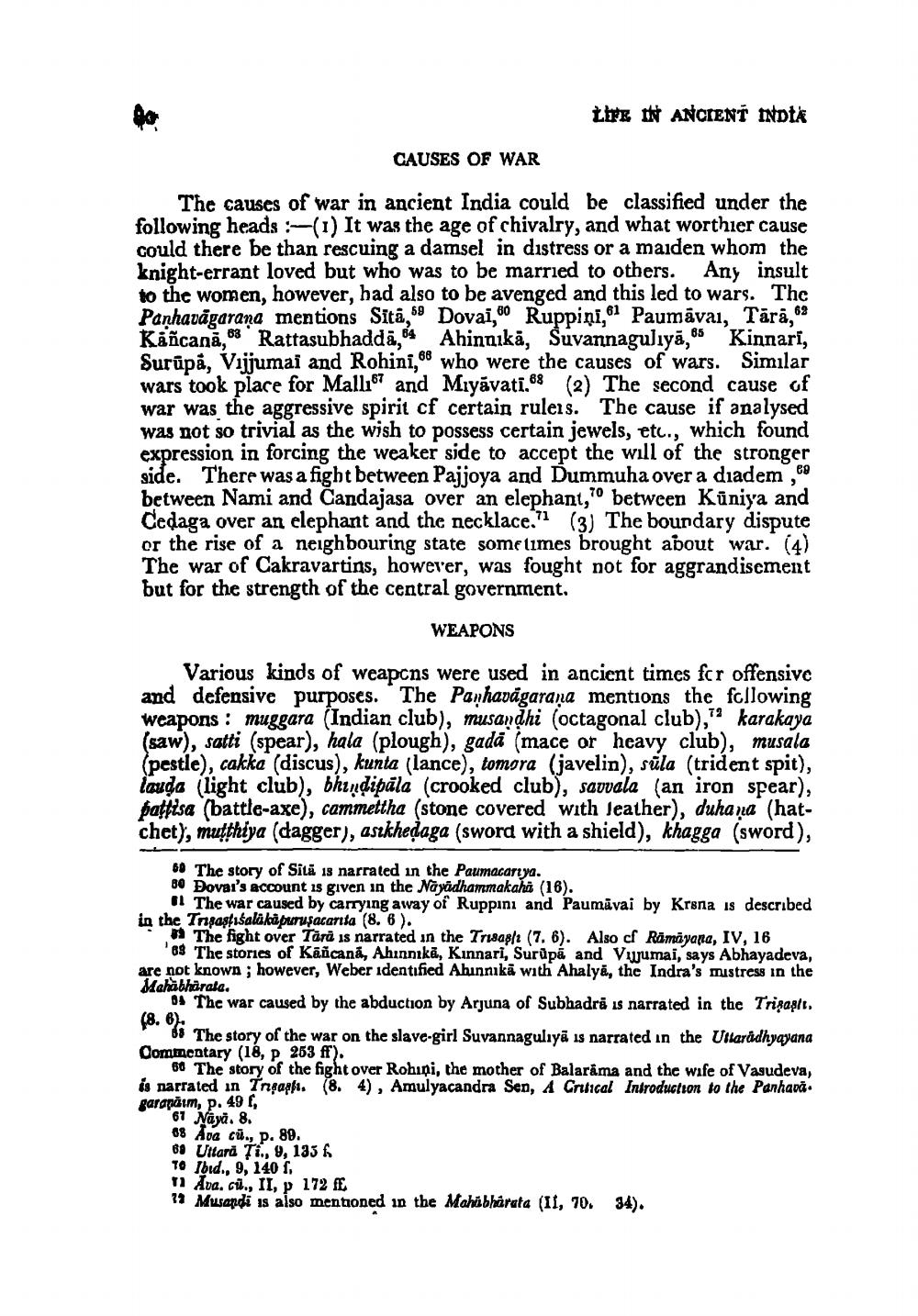________________
LIFE IN ANCIENT INDIA
CAUSES OF WAR
The causes of war in ancient India could be classified under the following heads (1) It was the age of chivalry, and what worthier cause could there be than rescuing a damsel in distress or a maiden whom the knight-errant loved but who was to be married to others. Any insult to the women, however, had also to be avenged and this led to wars. The Panhavågarana mentions Sità, so Dovai, Ruppiņi,61 Paumāvai, Tärä,62 Kancană, Rattasubhadda, 64 Ahinnikā, Suvannaguliyā,85 Kinnari, Surūpå, Vijjumai and Rohini, who were the causes of wars. Similar wars took place for Mall167 and Miyāvati,68 (2) The second cause of war was the aggressive spirit of certain rulers. The cause if analysed was not so trivial as the wish to possess certain jewels, etc., which found expression in forcing the weaker side to accept the will of the stronger side. There was a fight between Pajjoya and Dummuha over a diadem , between Nami and Candajasa over an elephant, between Kūniya and Cedaga over an elephant and the necklace." (3) The boundary dispute or the rise of a neighbouring state sometimes brought about war. (4) The war of Cakravartins, however, was fought not for aggrandisement but for the strength of the central government.
WEAPONS
Various kinds of weapons were used in ancient times for offensive and defensive purposes. The Panhavagarana mentions the following weapons : muggara (Indian club), musandhi (octagonal club)," karakaya (saw), satti (spear), hala (plough), gadā (mace or heavy club), musala (pestle), cakka (discus), kunta (lance), tomora (javelin), süla (trident spit), lauda (light club), bhindipāla crooked club), sauvala (an iron spear), patfisa (battle-axe), cammettha stone covered with leather), duhana (hatchet), mutthiya (dagger), asikhedaga (sword with a shield), khagga (sword),
48.6).
60 The story of Sita 18 narrated in the Paumacartya. 80 Dovai's account is given in the Nayadhammakaha (16).
Il The war caused by carrying away of Ruppını and Paumāvai by Krona is described in the Trisastišalaki buruşacarıda (8. 6).
The fight over Tarā is narrated in the Trusaslı (7. 6). Also cf Rāmāyana, IV, 16 '89 The stories of Kancană, Ahinnikā, Kinnari, Surūpā and Vuvumai, says Abhayadeva, are not known ; however, Weber identified Ahinnikā with Ahalya, the Indra's mistress in the Mahabharata.
04 The war caused by the abduction by Arjuna of Subhadrā is narrated in the Trisaslı,
$ The story of the war on the slave-girl Suvannaguliya is narrated in the Ullaradhyayana Commcntary (18, P 253 ff).
66 The story of the fight over Rohıņi, the mother of Balarama and the wife of Vasudeva, is narrated in Ingapfi. 78. 4), Amulyacandra Sen, A Critical Introduction to the Panhava. garapăim, p. 49 l,
61 Naya. 8.
8 loa cũ., P. 89. 89 Uttari Ti., 9, 133 f TO Ibid., 9, 140 f, TI Ava. cit., II, 172 fE 19 Musandi is also mentioned in the Mahübhârata (II, 70. 34).




